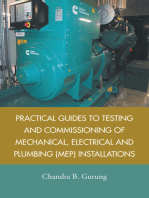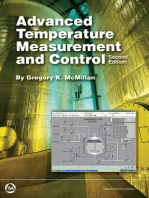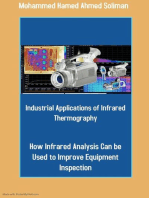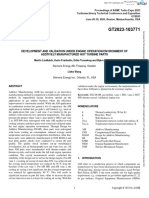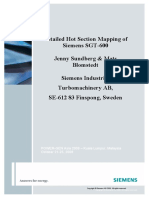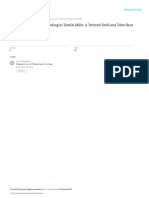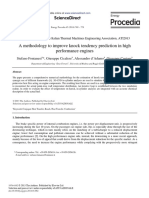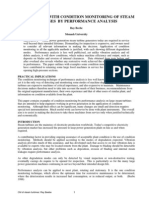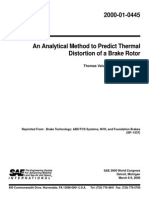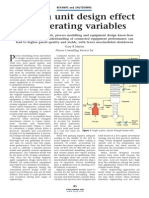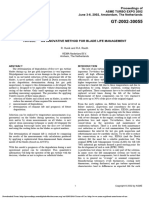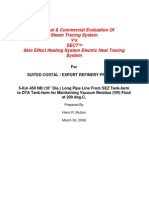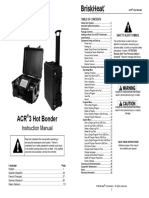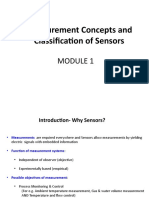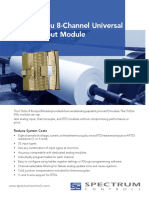Additively Manufactured Guide Vane With Integral Measurement System For Validation On Engine
Additively Manufactured Guide Vane With Integral Measurement System For Validation On Engine
Uploaded by
luca.bozzi74Copyright:
Available Formats
Additively Manufactured Guide Vane With Integral Measurement System For Validation On Engine
Additively Manufactured Guide Vane With Integral Measurement System For Validation On Engine
Uploaded by
luca.bozzi74Original Title
Copyright
Available Formats
Share this document
Did you find this document useful?
Is this content inappropriate?
Copyright:
Available Formats
Additively Manufactured Guide Vane With Integral Measurement System For Validation On Engine
Additively Manufactured Guide Vane With Integral Measurement System For Validation On Engine
Uploaded by
luca.bozzi74Copyright:
Available Formats
Downloaded from https://iranpaper.
ir
https://www.tarjomano.com https://www.tarjomano.com
Proceedings of ASME Turbo Expo 2022
Turbomachinery Technical Conference and Exposition
GT2022
June 13-17, 2022, Rotterdam, The Netherlands
GT2022-82132
Downloaded from http://asmedigitalcollection.asme.org/GT/proceedings-pdf/GT2022/86045/V06BT13A010/6935779/v06bt13a010-gt2022-82132.pdf by University of Edinburgh user on 18 December 2023
ADDITIVELY MANUFACTURED GUIDE VANE WITH INTEGRAL MEASUREMENT SYSTEM
FOR VALIDATION ON ENGINE
Oleg Naryzhnyy Martin Lindbaeck Petr Laletin Alexander Rotar
Siemens Energy Siemens Energy Siemens Energy Siemens Energy
Finspang, Sweden Finspang, Sweden Finspang, Sweden Finspang, Sweden
ABSTRACT NOMENCLATURE
Thermal validation of gas turbine components is one of the AM Additive Manufacturing
key activities performed for engine characteristics evaluation AF Airfoil
and verification of a newly developed product. There are several CMM Coordinate-Measuring Machine
standard thermal validation methods: thermal paint, thermal CCTR Comparative Cooling Test Rig
crystals and thermocouples (TC). However, measurement results GV Guide Vane
from all the above – mentioned techniques are affected by the ID Inner Diameter
design of the component or limited by the technological IR Infrared
conditions of the application. HTC Heat Transfer Coefficient
This article is related to the specific part design applied by KHTC HTC correction factor
additive manufacturing (AM) for the first-stage gas turbine vane. LE Leading Edge
Validation is performed by thermocouple measurement OD Outer Diameter
technique. Thermocouple gauges are instrumented inside the OEM Original Equipment Manufacturer
additively manufactured turbine vane without any negative OH Operation Hours
impacts on the part cooling system or key interfaces, such as hot P Pressure
gas surfaces, and as a result without impact on the operation of PS Pressure Side
the entire turbine component. RMS Remote Monitoring System
Moreover, since guide vanes were covered with thermal SS Suction Side
barrier coating (TBC), and the metal temperature was recorded TBC Thermal Barrier Coating
throughout the entire period of operation, it became possible to TC Thermocouple
capture and analyze the effect of aging of the TBC. It is well TE Trailing Edge
known that the properties of TBC change over time and bring TLC Thermochromic Liquid Crystals
uncertainty into the component thermal state. This is due to the
fact that the TBC conductivity value depends on the exposure
time and the exposure temperature.
Thermal validation work shown in this paper was performed
in frame of new AM product development and supports all stages
of product development process in Siemens Energy.
Keywords: thermal validation, additive manufacturing, gas
turbine vane, thermocouple.
V06BT13A010-1 Copyright © 2022 by ASME and Siemens Energy
Downloaded from https://iranpaper.ir
https://www.tarjomano.com https://www.tarjomano.com
1. INTRODUCTION
In general, there are four basic measurement techniques
used for thermal validation of the gas turbine components:
thermal paint, thermal crystal, high-speed infrared (IR)
monitoring system and thermocouples.
Downloaded from http://asmedigitalcollection.asme.org/GT/proceedings-pdf/GT2022/86045/V06BT13A010/6935779/v06bt13a010-gt2022-82132.pdf by University of Edinburgh user on 18 December 2023
Thermal paint and thermal crystal measurement methods do
not change the part design but are best suited for monitoring of
steady-state condition in dedicated short-duration test, require
special engine operational program and additional time for
evaluation of the collected data. Also, mentioned techniques
require engine stop and disassembly for collecting measurement FIGURE 1: SGT-700 GAS TURBINE
results.
High-speed IR monitoring system is also does not change The aim of this work was to replace a prior art turbine vane
the part design and is used for quicker validation of component design with an advanced cooling vane specifically adopted for
calculation models with improved information about the real additive manufacturing. The new vane has been designed to
temperatures in engine. This will reduce the risk with the maintain the hot gas path surfaces of airfoil and platforms, as
extended time between overhauls of engine components. well as the wedge, contact and other interfaces are the same as
However, this method is quite expensive and requires a on prior art vane. This is necessary so that the parts are
significant modification of turbine hardwire in order to install interchangeable. Design differences are inside the component.
this system. Airfoil (AF) cooling is performed by “in-wall” cooling channels
Temperature validation by use of TC’s could give very that are distributed along the leading edge, pressure side and
accurate values at any desired point in time, but this technique suction side of an airfoil, see Figure 2. Specified in-wall channels
leads to local changes of the cooling system design and therefore have entrances located in the outer and inner diameter (OD and
the measurements will be performed for a non-standard ID) platforms. Air passes through these channels and then blows
operational part design. In addition, the measurement is limited out to the internal cavity of airfoil. The air is then directed the
by the duration of the test and could not be performed in a trailing edge (TE) and exits through the TE pin bank.
standard operational gas turbine engine, since the instrumented The advantage of this design is high effective cooling
parts have reduced lifetime. system, which allow to have a more uniform temperature field
In a summary of the described methods, the validation over the surface.
results are accurate, however the validation processes have some
their specific disadvantages. However, application of AM
technology for thermocouple validation method looks quite
promising. The one of the advantages of AM is the possibility to
manufacture very complex and small-scale geometrical shapes.
Also, the technology allows for rapid production of new parts
design and modifications [1], [2]. This advantage makes it
possible to perform thermal validation on newly developed AM
turbine vane without any impacts on the part cooling system or
key interfaces, such as hot gas surfaces, and as the result without
impact on the operation of the turbine component.
2. NEW DEVELOPED PRODUCT, DESIGN
DESCRIPTION
Increasing the temperature of the hot gas at the turbine inlet FIGURE 2: SGT-700 AM GUIDE VANE 1 COOLING DESIGN
is the main driving factor for improving of efficiency of gas
turbine engine. However, the increase in temperature is limited 3. VALIDATION STRATEGY
by the material properties of hot gas path parts and, especially, A large-scale test campaign is developed and successfully
of the first turbine stage. Moreover, the implementation of implemented to mitigate the risks linked with limited experience
advanced cooling designs for the first stage turbine components with AM materials for cooled components of gas turbine [3].
is limited by conventional manufacturing methods, especially Conceptually it is as follows:
investment casting. • Testing on specimens/parts in specific laboratory
This article shows thermal validations works made for a conditions:
newly developed product in frame of AM program in Siemens o Water flow test. Airflow testing (mass flow and
Energy, particularly Guide Vane 1 for SGT-700. pressure tapping) and cut-up checks on specimens
to validate hydraulic models.
V06BT13A010-2 Copyright © 2022 by ASME and Siemens Energy
Downloaded from https://iranpaper.ir
https://www.tarjomano.com https://www.tarjomano.com
o Qualitative comparative cooling test rig (CCTR) platform going from internal cavity to outside, Figure 5. This
and quantitative IR-camera testing of printed once again demonstrates the flexibility of AM technology which
components. CCTR test is used to check if the “in- in this case helps to easily take pressure measurements. Good
wall” cooling channels are blocked. The IR-camera agreement between measured and predicted values of internal
test is used to validate heat transfer characteristics pressure, received during the test, (within ± 2%) indicates that
Downloaded from http://asmedigitalcollection.asme.org/GT/proceedings-pdf/GT2022/86045/V06BT13A010/6935779/v06bt13a010-gt2022-82132.pdf by University of Edinburgh user on 18 December 2023
of developed cooling schemes. the ratio between pressure losses on AF in-wall channels and
• Engine short term thermal validation: pressure losses on TE pin bank is very close to expectation.
o Metal temperature measurements using
thermocouples in a customer engine.
• Engine long term lifetime validation.
3.1 WATER AND COLD FLOW TEST
Water and cold flow tests are required for validation of the
cooling system. The first is a qualitative test, and it only needs to
visually check if there are blocked channels in guide vane, see
Figure 3. All parts were tested for water flow, there were no
clogged channels observed.
FIGURE 5: INTERNAL PRESSURE PROBE
3.2 IR-CAMERA TEST
There are different methods for measurement of heat
transfer. The IR-camera test is used, since the application of the
thermochromic liquid crystals (TLC) test is limited for AM
components due to high roughness of surfaces. IR-camera test is
applied for real part which has actual roughness and dimensions.
The objective of the IR-camera test campaign is to get a
basis for detailed calibration of the cooling model [7]. Transient
thermal imaging of guide vane external surface allows to
establish local heating rates and give a possibility for an indirect
FIGURE 3: AM GV. WATER FLOW TEST
validation of heat transfer coefficients applied to internal
channels.
The cold flow is a quantitative test and was performed for This method is well-known for Gas Turbines Original
all parts with the different flow configurations. The test result Equipment Manufacturer (OEM) and commonly used for
shows good matching with predicted values of massflow (±1%), validation of cooled components. The test rig consists of a
Figure 4. compressed air supply system that supplies air to the guide vane
and a bypass to regulate the required inlet temperature. Upstream
of the vane the flow meter measures the flow rate entering the
model. The air temperature and pressure at the inlet to the vane
are measured with sensors. The test setup is presented in Figure
6.
FIGURE 4: AM GV. COLD FLOW TEST
It should be noted that for this cooling design, the main
parameters are temperature and pressure in the inner cavity of
the airfoil. For the pressure measurement there was printed a
guide vane with integrated channel in outer diameter (OD) FIGURE 6: RIG FOR IR-CAMERA TEST
V06BT13A010-3 Copyright © 2022 by ASME and Siemens Energy
Downloaded from https://iranpaper.ir
https://www.tarjomano.com https://www.tarjomano.com
The external surface of the vane was covered with black
paint, and the surface temperature was obtained using an infrared
camera. Tests were done separately for pressure side, suction
sides, and leading edge (LE) regions.
Example of IR-image is shown in Figure 7.
Downloaded from http://asmedigitalcollection.asme.org/GT/proceedings-pdf/GT2022/86045/V06BT13A010/6935779/v06bt13a010-gt2022-82132.pdf by University of Edinburgh user on 18 December 2023
FIGURE 8: METAL TEMPERATURE COMPARISON BETWEEN
THERMAL-HYDRAULIC MODEL AND IR CAMERA
FIGURE 7: IR IMAGE IN A TIME MOMENT 3.4 AM GV DESIGN FOR THERMAL VALIDATION
TEST
Figure 8 shows the points containing metal temperature data Instrumentation with thermocouples for metal temperature
for airfoil from the IR-camera mapped into the thermal-hydraulic measurement is detailed in Figure 9. The key feature is that such
model. Depending on the camera resolution the quantity of such a scheme does not affect the cooling system. On the cold side
points can reach several thousand. For this particular case 60 there are additional channels for TC installation. Additionally,
points are sufficient. The transient metal temperature curves for for validation it is needed to measure the air temperature in the
several of them are presented as an example [4], [5]. internal cavity i.e., heat pick up in the airfoil cooling channels.
During heat transfer rig data evaluation, the following
approach was applied:
• Heat transfer coefficients (HTC) for “in-wall” cooling
channels are described by Dittus-Boelter correlations;
• As a result of IR-camera test heat transfer coefficient
enhancement factors (KHTC) should be obtained;
• The value of this correction factor was applied per each
hydraulic branch and for whole “in-wall” channel;
• This value was varied manually in a series of transient
calculations, until good match of measured and
calculated temperatures was achieved.
A series of thermal calculations with various KHTC in the
range from 1.0 to 2.0 were performed. 2D transient plots are FIGURE 9: AM GV MODEL FOR THERMAL VALIDATION
shown in Figure 8. The reasonable level of correction in the
range of 1.5 and 2.0. The solution was to add one or several channels for
Finally, an HTC correction factor equals to KHTC=1.6 was installation of thermocouples measurement gauges without
used as it gives the best match of the calculated temperature with adapting the existing cooling design. The channels run along the
the measured. Moreover, it should be noted that this factor is in existing airfoil walls and can be placed at the required
good agreement with the ASME publication [6]. measurement points. Such channels can be produced in any
The test parameters were determined based on the law of location. In the example shown, the channels are located on both
similarity. Reynolds numbers for the internal cooling channels the suction side and pressure side of the airfoil for the top, middle
correspond to Reynolds numbers under engine operating and bottom sections. The entrances to these channels are located
conditions. For testing, a real non-scaled metal guide vane was in the outer diameter platform, which makes it easy to put the
used. The test was carried out using air, so Prandtl numbers for thermocouple probe through the outer hole.
testing and engine operating conditions are the same. Thus, the The general advantages and key benefits of newly
enhancement factors defined during the test with an IR camera are developed additive manufacturing design for thermal validation
valid for engine operating conditions. process are:
• The design of the cooling system is unchanged without
affecting of the component lifetime.
V06BT13A010-4 Copyright © 2022 by ASME and Siemens Energy
Downloaded from https://iranpaper.ir
https://www.tarjomano.com https://www.tarjomano.com
• Position and number of thermocouples depends only on
accessibility for application.
• The measurements could be performed in a chosen time
moment without impact on an engine operational state
and moreover could be done during the standard
Downloaded from http://asmedigitalcollection.asme.org/GT/proceedings-pdf/GT2022/86045/V06BT13A010/6935779/v06bt13a010-gt2022-82132.pdf by University of Edinburgh user on 18 December 2023
operation conditions.
• Additive manufacturing design allowed to avoid special
instrumentation procedures required for component,
and the time for instrumentation would be sufficiently
reduced.
• It’s not required to perform engine stop and
disassembly to collect the entire results that leads to
reduce validation process timeline. FIGURE 11: PRINTED AM GV
• The result of measurements does not require further
evaluations and could be analyzed straight from the In Figure 12 shown the machined and coated guide vane.
measurement moment
Finally, the number of measurements were reduced to the
three temperature measurements. Special channels for TC were
introduced into the AM guide vane model, as shown on Figure
9.
Boundary conditions and wall metal temperature around TC
head are presented on Figure 10. Due to the TC being located in
an area with the low metal temperature gradient (behind the
cooling channels) the expected difference between the “hot” and
“cold” walls is only 2ºC. It means that it doesn’t matter which
wall will be in contact with thermocouple due to the small
difference between their temperatures. Contact value between
TC head and walls also doesn’t matter for Steady State condition
because the temperature of the thermocouple will be equal to the
FIGURE 12: MACHINED (LEFT) AND COATED (RIGHT) GV
temperature of the wall in this location.
5. INSTRUMENTATION AND VALIDATION
In accordance with validation strategy the temperature test
should be performed for guide vane with TCs on the customer
engine. Three instrumented GV for metal and air temperature
measurements were installed.
There was no impact on engine assembly from design point
of view due to following:
• AM vane design interfaces are kept unchanged
compared to baseline component;
FIGURE 10: BC AND WALL METAL TEMPERATURE
• Small parts (inner, outer sleeves; OD & ID sealing
AROUND TC HEAD
strips) are the same as for baseline vane;
• Hot gas path surfaces (airfoil, OD & ID hot gas
4. MANUFACTURING AND QUALITY CHECK
surfaces) are kept the same as for baseline component.
In order to guarantee same quality of instrumented and
The vanes will be installed and then removed during
standard AM guide vanes, it is necessary to pass guide vanes
scheduled maintenance work.
through the same manufacturing sequence and to perform same
Before implementing the thermocouple design for vanes, a
volume of quality checks as for the standard, see Figure 11.
lab test was performed to compare different methods of
Quality steps included are geometry measurements with
thermocouple installations - additively manufactured holes
coordinate-measuring machine (CMM) and white light scanning,
versus the standard soldering installation. This test was done by
flow checking, microstructure analysis and material testing,
exposing the test objects to a sudden increase in temperature and
measurements of surface roughness.
monitoring the behavior of the thermocouples. The difference in
result between two installation methods was minor. The only the
risk was observed, when the thermocouples installed in area with
high metal temperature gradient. Therefore, for TC installation
was selected an area in AM vane with the low metal temperature
V06BT13A010-5 Copyright © 2022 by ASME and Siemens Energy
Downloaded from https://iranpaper.ir
https://www.tarjomano.com https://www.tarjomano.com
gradient. The benefits of this approach have described in chapter
3.4 regarding boundary conditions. This solution makes our
design robust and simple, while we can eliminate many factors
that can affect the design and at the end, measurements.
The AM Vane design has been customized with two radial
Downloaded from http://asmedigitalcollection.asme.org/GT/proceedings-pdf/GT2022/86045/V06BT13A010/6935779/v06bt13a010-gt2022-82132.pdf by University of Edinburgh user on 18 December 2023
channels for metal temperature measurements and one central
hole for measurement of the air temperature inside of the airfoil
internal cavity.
In order to seal and fix thermocouples on guide vane, collars
are used, that will be brazed together with TCs, Figure 13. The
“short” type of collars will be placed in channels intended for
metal temperature measurements, and the “long” collar will be
used in central hole, and it functions to guide the TC probe inside FIGURE 15: AM GV THERMOCOUPLES LEAD OUT (LEFT).
the cavity. Then TCs with collars are sealed by spot welding. INSTRUMENTATION ON CUSTOMER ENGINE
5.1 TEMPERATURE MONITORING, TBC AGING
EFFECT
Continuous temperature measurements from thermocouples
are available in RMS. This is database with measured data from
Siemens Energy gas turbines. The data is monitored regularly
after the customer's engine is started. In Figure 16, shown how
the temperature measurements on our three vanes change over
time from commissioning to the present.
FIGURE 13: AM GV INSTRUMENTATION DESIGN – METAL
AND AIR TEMPERATURE PROBES
Figure 14 shows a guide vane with installed thermocouples
and 3 instrumented additively manufactured guide vanes
installed in the customer engine.
FIGURE 16: AM GV CONTINUOUS TEMPERATURE
MONITORING
To have the basis for metal temperature validation, the
FIGURE 14: INSTRUMENTED AM GV BEFORE (LEFT) AND following actions were taken with thermal-hydraulic model to
AFTER RING ASSEMBLY (RIGHT) bring it to the engine test conditions:
• the hydraulic model remains the same as the flow
As presented in Figure 15, the TC wires are easily led out measurement is in good agreement with the flow specification;
through existing sleeve’s orifice (right) and through the standard • aero and secondary air flow boundary conditions were
lead out part called “mushroom”, which is installed to the used for operating conditions;
standard hole of turbine casing (left). • TBC coated scheme was modified in accordance with
manufacturing data, so thickness values were applied to the
model according to measurement from coating lab reports.
Here it is also necessary to note the important factor as the
TBC conductivity. Its behavior is a point of discussion, since it
has some features that distinguish it from design case. Analysis
of the available data showed that the TBC conductivity can be
0.8-1.0 W/mK [8] and 0.7-0.9W/mK [9].
V06BT13A010-6 Copyright © 2022 by ASME and Siemens Energy
Downloaded from https://iranpaper.ir
https://www.tarjomano.com https://www.tarjomano.com
The fact is that the TBC conductivity value depends on the 6. CONCLUSION
exposure time and exposure temperature. At the beginning, the Thermal tests described in this paper was performed on a
conductivity is low due to the porosity level and stable newly developed component where cooling system is unchanged
microstructure, there are no microcracks. During engine therefore without affecting of the component lifetime. TC
operation, the sintering process reduces porosity, and cycling application on component has been performed without special
Downloaded from http://asmedigitalcollection.asme.org/GT/proceedings-pdf/GT2022/86045/V06BT13A010/6935779/v06bt13a010-gt2022-82132.pdf by University of Edinburgh user on 18 December 2023
results in the formation of microcracks on the surface, which instrumentation procedures, which usually requires the rework
increases thermal conductivity. At some point this process fade of component. The temperature measurements have been taken
and the conductivity value stabilized. In this case, the TBC in a chosen time moment without impact on an engine
conductivity value was taken as half of the nominal value, which operational state. There was no requirement to perform engine
is relevant for a virgin TBC and a given exposure temperature, stop and disassembly for collecting results, the measurements
Figure 17. were analyzed straight from the taken moment without any
The measured temperatures increased steadily and were in additional evaluations. It should also be noted that this approach
line with forecast for the new TBC conductivity. According to has a benefit for newly developed product as a lifetime indicator.
the data, only after 5000 hours of operation TBC conductivity Any significant drop in temperature will be recorded and
begins to approach the nominal value. signaling a problem with the component.
This paper illustrates that using AM technology as
manufacturing method for thermal validation process is simple,
robust, and effective.
All activities and results shown in this article were
performed in frame of new AM product development and
supports all stages of product development process in Siemens
Energy.
ACKNOWLEDGEMENTS
The authors would like to thank Siemens Energy for the
FIGURE 17: TBC CONDUCTIVITY VS. EXPOSURE TIME opportunity being involved to so innovative work and to all the
people involved in this work.
5.2 BOROSCOPE INSPECTION ON CUSTOMER
ENGINE REFERENCES
After 5900 operation hours (OH) the 3 instrumented [1] “Siemens achieves breakthrough with 3D printed gas
additively manufactured guide vanes were borescope inspected turbine blades”, press release.
during scheduled engine stop (Figure 18). Parts found in a good https://press.siemens.com/global/en/pressrelease/siemens-
condition, there are no evidence of higher temperature like bright achieves-breakthrough-3d-printed-gas-turbine-blades
color of the TBC. The dark spots are the results of interaction https://www.youtube.com/watch?v=8vtLtu4ZYsQ
with discrete flows from OD liner cooling holes and it is not [2] Makley, B. “Additive manufacturing injecting new life
related to the thermocouples installation. The thermal into legacy gas turbines” https://assets.siemens-
calculations carried out at the design phase showed same picture energy.com/siemens/assets/api/uuid:5a4743eb-0eb0-4a98-a8ea-
and they are in good agreement with the measurement results. c6120d537d6a/drewagarticlefromgasturbineworld.pdf
Both, calculations and measurement, did not show any [3] Wimmer, T., Reuhmer, T., Mick, Y., Wang,
unexpected high temperatures. L.,Weigand., B., 2019. “Experimental and numerical
investigation on an additively manufactured gas turbine ring
segment with an in-wall cooling”. Proceedings of ASME Turbo
Expo. GT2019-90227.
[4] Vassiliev V, Kostege V., Schnedler P., Trishkin A. 2005.
“Thermal State Analysis of Industrial Gas Turbine Blades”.
ASME. Turbo Expo: Power for Land, Sea, and Air Volume 3,
GT2005-68951. pp. 813-824.
[5] Kostege, V. K., Halturin, V. A. and Sundurin, V. G.
1994. “Simulation of Multidisciplinary Problems for the
Thermostress State of Cooled High Temperature Turbines”.
AGARD Lecture Series: Mathematical Models of Gas Turbine
Engines and Their Components, TCP 02/LS198, pp. 1-9
[6] Paul Sanders, Lieke Wang. “Impact of Additive
Manufacturing on Internal Cooling Channels with Varying
FIGURE 18: AM GV BOROSCOPE INSPECTION
Diameters and Build Directions”, GT2020-15049
V06BT13A010-7 Copyright © 2022 by ASME and Siemens Energy
Downloaded from https://iranpaper.ir
https://www.tarjomano.com https://www.tarjomano.com
[7] Kinell, M., Utriainen, E., Jaksch, P., 2014. “An
alternative experimental method for establishing detailed
internal heat transfer coefficient distributions of complex cooling
geometries using IR thermography”. Proceedings of ASME
Turbo Expo. GT2014-25616
Downloaded from http://asmedigitalcollection.asme.org/GT/proceedings-pdf/GT2022/86045/V06BT13A010/6935779/v06bt13a010-gt2022-82132.pdf by University of Edinburgh user on 18 December 2023
[8] A.J. Slifka, Thermal-Conductivity Apparatus for Steady-
State, Comparative Measurement of Ceramic Coatings, J. Res.
Natl. Inst. Stand. Technol. 105, 591 (2000)
[9] Wahiduzzaman, S and Morel, T., Effect of Translucence
of Engineering Ceramics on Heat Transfer in Diesel Engines,
ORNL/Sub/88-22042/2, April 1992
V06BT13A010-8 Copyright © 2022 by ASME and Siemens Energy
You might also like
- Hot Turbine Guide Vane Performance Improvement With Metal Additive Manufacturing at Siemens EnergyDocument8 pagesHot Turbine Guide Vane Performance Improvement With Metal Additive Manufacturing at Siemens Energyluca.bozzi74No ratings yet
- Practical Guides to Testing and Commissioning of Mechanical, Electrical and Plumbing (Mep) InstallationsFrom EverandPractical Guides to Testing and Commissioning of Mechanical, Electrical and Plumbing (Mep) InstallationsRating: 4 out of 5 stars4/5 (4)
- Advanced Temperature Measurement and Control, Second EditionFrom EverandAdvanced Temperature Measurement and Control, Second EditionNo ratings yet
- ESA-TECMSP-TN-007384 Rev2 - Process Verification of Altenative Chemical Conv Coating - SurtecDocument6 pagesESA-TECMSP-TN-007384 Rev2 - Process Verification of Altenative Chemical Conv Coating - Surtecgoooga299No ratings yet
- Industrial Applications of Infrared Thermography: How Infrared Analysis Can be Used to Improve Equipment InspectionFrom EverandIndustrial Applications of Infrared Thermography: How Infrared Analysis Can be Used to Improve Equipment InspectionRating: 4.5 out of 5 stars4.5/5 (3)
- Wrong Answer SummaryDocument3 pagesWrong Answer Summaryavishek mishra100% (2)
- Exhaust Temperature SpreadDocument5 pagesExhaust Temperature Spreadchdeepak9691% (11)
- Therm o Disc Complete Catalog 1-10-19 en Us 5312494Document206 pagesTherm o Disc Complete Catalog 1-10-19 en Us 5312494Elvis FariasNo ratings yet
- Development and Validation Under Engine Operation Environment of Addtively Manufactured Hot Turbine PartsDocument10 pagesDevelopment and Validation Under Engine Operation Environment of Addtively Manufactured Hot Turbine Partsluca.bozzi74No ratings yet
- Development of Additive Manufacturing Gas Turbine Hot Gas Path Vanes at Baker HughesDocument8 pagesDevelopment of Additive Manufacturing Gas Turbine Hot Gas Path Vanes at Baker Hughesluca.bozzi74No ratings yet
- Imece2014 38164 PDFDocument9 pagesImece2014 38164 PDFYemane TesfayeNo ratings yet
- Article Optical PyrometryDocument8 pagesArticle Optical PyrometryCowdrey IlanNo ratings yet
- Sistaninia 2017Document5 pagesSistaninia 2017Hiwa KhalediNo ratings yet
- Detailed Hot Section Mapping of Siemens SGT 600 PDFDocument19 pagesDetailed Hot Section Mapping of Siemens SGT 600 PDFfrdn100% (1)
- Siemens SGT5 4000F Performance MeasuremeDocument9 pagesSiemens SGT5 4000F Performance Measuremerudiyanareface100% (1)
- 2012 Practical Strategies For Improved Cooling of Electrical Motors and Generators Dave Staton INDUCTICA TECHNICAL CONFERENCE PDFDocument8 pages2012 Practical Strategies For Improved Cooling of Electrical Motors and Generators Dave Staton INDUCTICA TECHNICAL CONFERENCE PDFuuur35No ratings yet
- Assestment Steam TurbineDocument19 pagesAssestment Steam TurbineFallo SusiloNo ratings yet
- CAVTDocument4 pagesCAVTRaj EaswarmoorthiNo ratings yet
- Sat NwekepaperDocument11 pagesSat Nwekepaperpasquale rispoliNo ratings yet
- Optimizing Engine Oil Cooling in Textile Mills: A Twisted Shell and Tube Heat Exchanger ApproachDocument42 pagesOptimizing Engine Oil Cooling in Textile Mills: A Twisted Shell and Tube Heat Exchanger ApproachKhan Yishtiaq RaatulNo ratings yet
- Be1227 Inductica 2012 Paper MDL PDFDocument8 pagesBe1227 Inductica 2012 Paper MDL PDFRandhir SwarnkarNo ratings yet
- Reverse Engineering of A Five Stage Centrifugal Compressor RotorDocument13 pagesReverse Engineering of A Five Stage Centrifugal Compressor RotorMahmoud AbdellatifNo ratings yet
- 32687-1 The Light Cinema-BanburyDocument9 pages32687-1 The Light Cinema-Banburyamith_kmNo ratings yet
- Application of A Small Deviation Method in The StuDocument10 pagesApplication of A Small Deviation Method in The Sturaphael.marinsNo ratings yet
- Integrated Test Systems With Hot Gas Generator For The Development of Turbocharger ApplicationsDocument7 pagesIntegrated Test Systems With Hot Gas Generator For The Development of Turbocharger ApplicationsravigobiNo ratings yet
- Unsteady Flow Visualisation T Akes The Heat Out of Hot SpotsDocument2 pagesUnsteady Flow Visualisation T Akes The Heat Out of Hot SpotsDeepak Chachra100% (1)
- 60MW-Turbine Life AnalysisDocument11 pages60MW-Turbine Life AnalysisAt YugovicNo ratings yet
- A Methodology To Improve Knock Tendency Prediction in High Performance EnginesDocument10 pagesA Methodology To Improve Knock Tendency Prediction in High Performance EnginesAndre QuirnbachNo ratings yet
- 723ijarse PDFDocument19 pages723ijarse PDFMahsaNo ratings yet
- Turbocharger PerformanceDocument106 pagesTurbocharger Performanceashwynvinay_90182279100% (4)
- Improved Power Plant PerformanceDocument3 pagesImproved Power Plant Performanceshams100% (2)
- Towards The Future of Gas Turbine Asset - T.alevarez - EndesaDocument3 pagesTowards The Future of Gas Turbine Asset - T.alevarez - EndesaTony EduokNo ratings yet
- Influence of Temperature On Power FactorDocument10 pagesInfluence of Temperature On Power Factorrasim_m1146No ratings yet
- Turbines Paper Ray BeebeDocument9 pagesTurbines Paper Ray Beebealiscribd46No ratings yet
- GT2012 69617Document9 pagesGT2012 69617luca.bozzi74No ratings yet
- SGT5 8000H Experimental Test Results andDocument10 pagesSGT5 8000H Experimental Test Results andHossein MohammadiNo ratings yet
- Eto23a - Boiler AutomationDocument31 pagesEto23a - Boiler AutomationKrishna RamaNo ratings yet
- GT2017 63242Document12 pagesGT2017 63242Viet LeNo ratings yet
- V10at29a002 gt2022 78311Document12 pagesV10at29a002 gt2022 78311Kendra KaiserNo ratings yet
- Technological Development - Health Monitoring - Maximizing Efficiency - Advance Communication System - Regulatory and Environmental IssuesDocument37 pagesTechnological Development - Health Monitoring - Maximizing Efficiency - Advance Communication System - Regulatory and Environmental IssuesAnonymous pKsr5vNo ratings yet
- Steam Turbine Rotor Transient Thermo Structural Analysis and Lifetime PredictionDocument8 pagesSteam Turbine Rotor Transient Thermo Structural Analysis and Lifetime PredictionOoi Ban Juan100% (1)
- Sae Technical Paper Series: Thomas Valvano and Kwangjin LeeDocument8 pagesSae Technical Paper Series: Thomas Valvano and Kwangjin Leepurus12No ratings yet
- Numerical Analysis of A Two-Phase Turbine: A Comparative Study Between Barotropic and Mixture ModelsDocument16 pagesNumerical Analysis of A Two-Phase Turbine: A Comparative Study Between Barotropic and Mixture Modelsp ppNo ratings yet
- Powergen Europe 2014, Cologne: Gas Turbine Short and Long Term Operation and Failure MechanismsDocument13 pagesPowergen Europe 2014, Cologne: Gas Turbine Short and Long Term Operation and Failure MechanismsKR PANo ratings yet
- Shevchenko 2017 J. Phys. Conf. Ser. 891 012255Document7 pagesShevchenko 2017 J. Phys. Conf. Ser. 891 012255senthilNo ratings yet
- Vacuum Unit Design Effect On Operating VariablesDocument6 pagesVacuum Unit Design Effect On Operating VariablesIrawan SetiadiNo ratings yet
- 7 MotorCADDocument18 pages7 MotorCADkhodabandelouNo ratings yet
- Small Gas Turbine GTM-120 BenchDocument8 pagesSmall Gas Turbine GTM-120 BenchFurqanNo ratings yet
- CEA Guidelines For Supercritical Thermal Power Plant (BTG)Document222 pagesCEA Guidelines For Supercritical Thermal Power Plant (BTG)shanmars007100% (4)
- Analysis and Experimental Research On The Influence of VVT Point Selection On Exhaust Temperature in Low Speed Operating ConditionsDocument8 pagesAnalysis and Experimental Research On The Influence of VVT Point Selection On Exhaust Temperature in Low Speed Operating Conditionsrosca raulNo ratings yet
- RITMDocument7 pagesRITMAliNo ratings yet
- Hunik 2002Document9 pagesHunik 2002Hiwa KhalediNo ratings yet
- Technical Review-MAPNA TUGA 17Document44 pagesTechnical Review-MAPNA TUGA 17Mohammad Gharehkhani100% (1)
- Steam Turbine Rotor Straightening MD&ADocument3 pagesSteam Turbine Rotor Straightening MD&AMohammadreza GalebanNo ratings yet
- Welcome To International Journal of Engineering Research and Development (IJERD)Document6 pagesWelcome To International Journal of Engineering Research and Development (IJERD)IJERDNo ratings yet
- Computational Fluid Flow AnalysisDocument6 pagesComputational Fluid Flow AnalysisRiddhesh PatelNo ratings yet
- Optimization and Design Analysis of SteaDocument6 pagesOptimization and Design Analysis of SteaMahad KhanNo ratings yet
- Pe D A09134227266 Ge Sow 003 01 E - Sow Epcm Sgi MunteniDocument13 pagesPe D A09134227266 Ge Sow 003 01 E - Sow Epcm Sgi MunteniIoana PopescuNo ratings yet
- Technical Commercial Evaluation Steam Tracing Vs SECT5 KM 450 NBMarch 022008200 CDocument15 pagesTechnical Commercial Evaluation Steam Tracing Vs SECT5 KM 450 NBMarch 022008200 CleakNo ratings yet
- Siemens 1 GTX 100 TurbineDocument16 pagesSiemens 1 GTX 100 Turbinejparmar100% (1)
- Saep 317Document22 pagesSaep 317brecht1980100% (1)
- Estimator's Piping Man-hours Tool: Estimating Man-hours for Carbon Steel Process Piping Projects. Manual of Man-hours, ExamplesFrom EverandEstimator's Piping Man-hours Tool: Estimating Man-hours for Carbon Steel Process Piping Projects. Manual of Man-hours, ExamplesNo ratings yet
- Gas-Engines and Producer-Gas Plants A Practice Treatise Setting Forth the Principles of Gas-Engines and Producer Design, the Selection and Installation of an Engine, Conditions of Perfect Operation, Producer-Gas Engines and Their Possibilities, the Care of Gas-Engines and Producer-Gas Plants, with a Chapter on Volatile Hydrocarbon and Oil EnginesFrom EverandGas-Engines and Producer-Gas Plants A Practice Treatise Setting Forth the Principles of Gas-Engines and Producer Design, the Selection and Installation of an Engine, Conditions of Perfect Operation, Producer-Gas Engines and Their Possibilities, the Care of Gas-Engines and Producer-Gas Plants, with a Chapter on Volatile Hydrocarbon and Oil EnginesNo ratings yet
- OIMLDocument15 pagesOIMLRameshNo ratings yet
- Sensor Characteristics: (Part One)Document31 pagesSensor Characteristics: (Part One)morton1472No ratings yet
- Experi Met 06Document7 pagesExperi Met 06Daniel Carlos Vidal DíazNo ratings yet
- E5cn 1189724Document26 pagesE5cn 1189724Todi FindraNo ratings yet
- Astm C892 (2005)Document5 pagesAstm C892 (2005)Delta akathehuskyNo ratings yet
- Topic 5 Fundamentals of Robots 2Document46 pagesTopic 5 Fundamentals of Robots 2Elvis OmondiNo ratings yet
- Acr3 Hot Bonder Instruction Manual 41039 03Document70 pagesAcr3 Hot Bonder Instruction Manual 41039 03Tan Chin Tuan MichaelNo ratings yet
- Ajinkya Electronic Systems Ajinkya Electronic Systems: FeaturesDocument2 pagesAjinkya Electronic Systems Ajinkya Electronic Systems: FeaturesYash DumaswalaNo ratings yet
- 06 0625 32 2015 91111.inddDocument2 pages06 0625 32 2015 91111.inddRana SlimNo ratings yet
- Thermophysical Properties of Orange JuiceDocument14 pagesThermophysical Properties of Orange JuiceGladys González González100% (1)
- DIL 805 Quenching Dilatometer BrochureDocument14 pagesDIL 805 Quenching Dilatometer BrochureDeniz ShenNo ratings yet
- PB Se Ev enDocument12 pagesPB Se Ev enback1949No ratings yet
- Temperature Sensor Types For Temperature MeasurementDocument8 pagesTemperature Sensor Types For Temperature MeasurementcesarinigillasNo ratings yet
- IMO Isocon-6 Isolating Signal ConverterDocument16 pagesIMO Isocon-6 Isolating Signal ConverterltrongluanvnNo ratings yet
- CWFDocument10 pagesCWFYessy MalindaNo ratings yet
- ME320 Lab A - AmanDocument9 pagesME320 Lab A - Amanlychung2No ratings yet
- High-Temperature Static Strain Measurement: Standard Guide ForDocument10 pagesHigh-Temperature Static Strain Measurement: Standard Guide ForAxel GozalezNo ratings yet
- Cooperheat TAU Tech SpecDocument2 pagesCooperheat TAU Tech SpecNDTPISC - RLMNo ratings yet
- Measurement Concepts and Classification of SensorsDocument26 pagesMeasurement Concepts and Classification of SensorsArvind kumar PrajapatiNo ratings yet
- XS Hardware ManualDocument57 pagesXS Hardware ManualGOST TECH GOST-технологияNo ratings yet
- 1762sc If8u DatasheetDocument2 pages1762sc If8u DatasheetDanny PuchaNo ratings yet
- Electrical Measurements and Instrumentation (Introduction To Instrumentation Engineering) 3/1/21Document30 pagesElectrical Measurements and Instrumentation (Introduction To Instrumentation Engineering) 3/1/21tesfaye meberateNo ratings yet
- Elx RGF Lee Dickens Aa-BlockDocument1 pageElx RGF Lee Dickens Aa-BlockBadrian BadbadNo ratings yet
- Thermocouple CompensatorDocument7 pagesThermocouple CompensatorArnab MondalNo ratings yet
- Instrumrnt SpecificationDocument24 pagesInstrumrnt SpecificationHarun RashidNo ratings yet
- All Vdo Sensors CatalogueDocument96 pagesAll Vdo Sensors CatalogueAdeel0% (1)
- Chapter 0006Document7 pagesChapter 0006Dr Ravi Kumar A VNo ratings yet

